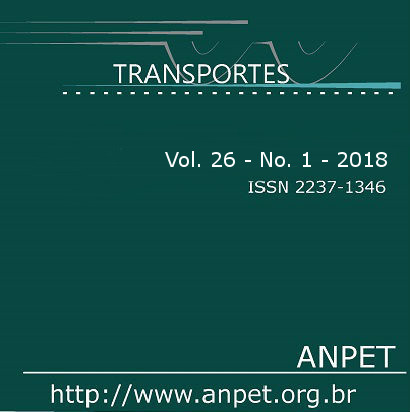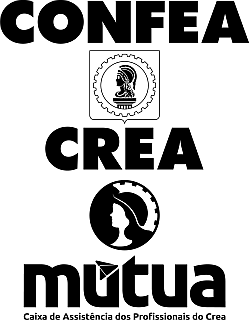Correlação da energia de fratura com parâmetros reológicos de ligantes e mástiques asfálticos
DOI:
https://doi.org/10.14295/transportes.v26i1.1150Palavras-chave:
Fíler mineral, Mástique asfáltico, Propriedades reológicas, Energia de fratura, Trinca por fadiga.Resumo
A energia de fratura é uma propriedade relacionada com a contribuição de ligantes asfálticos à resistência à fadiga de misturas asfálticas e, portanto, tem grande influência no comportamento mecânico de pavimentos flexíveis, particularmente no desenvolvimento e propagação de trincas. Esta pesquisa tem o objetivo de contribuir para um melhor entendimento dos efeitos do fíler mineral e do ligante asfáltico na relação da energia de fratura com os parâmetros reológicos de ligantes e mástiques asfálticos, em temperaturas intermediárias. Para a determinação da energia de fratura foi realizado o ensaio Binder Fracture Energy (BFE), desenvolvido na Universidade da Flórida, em função do tipo e teor do fíler mineral e do ligante asfáltico. Os resultados mostram que a energia de fratura pode ser relacionada com o módulo de cisalhamento dinâmico (G*) e com o ângulo de fase (δ), obtidos em ensaios no reômetro de cisalhamento dinâmico (DSR), com a rigidez [S(t)] e com a taxa de relaxação [m(t)], obtidos em ensaios de fluência de viga à flexão (BBR).
Downloads
Referências
Anderson, D.A. e R. Dongre (1995) The SHRP Direct Tension Specification Test – Its Development and Use. Physical Properties of Asphalt Cement Binders, J.C. Hardin, Ed. ASTM Special Technical Publication 1241.
American Society for Testing and Ma-terials, Philadelphia, PA, p. 51-66.
Anderson, D. A.; L. Lapalu; M.O. Marasteanu; Y. M. L. Hir; J. P. Planche e D. Martin (2001) Low-temperature thermal cracking of asphalt binders as ranked by strength and fracture properties, Journal of the Transportation Research Board, v. 1766, p.1-6.
Bahia, H.; H. Wen e C.M. Johnson (2010) Developments in intermediate temperature binder specifications. Transportation Research Circular, E-C147, December, p.25-33.
Hoare, T. R. e S.A. Hesp (2000) Low-temperature fracture testing of asphalt binders, Journal of the Transportation Research Board, v. 1728, p.36-42.
Huang, S. C.; J. C. Petersen; R. E. Robertson e J. F. Branthaver (2001) Effect of Hydrated Lime on the Long-Term Oxidative Aging Characteristics of Asphalt. Transportation Research Record
Huang, S.C.; J. C. Petersen; R. E. Robertson e J. F. Branthaver (2002) Effect of hydrated lime on long-term oxidative aging characteristics of asphalt. Transportation Research Record, n. 1810, p. 17-24.
Huang, S. C e M. ZENG (2007) Characterization of aging effect on rheological properties of asphalt-filler systems. International Journal of Pavement Engineering, v. 8, n. 3, p. 213–223
Ishai, I. e J. Craus (1977) Effects of the Filler on Aggregate-Bitumen Adhesion Properties in Bituminous Mixtures. Proceedings of the Association of Asphalt Paving Technologists, v. 46, p. 228-258.
Kim, Y.R.; D.N. LITTLE e I. Song (2003) Effect of mineral fillers on fatigue resistance and fundamental material characteristics – mechanic evaluation. Transportation Research Record, no.1832, Transportation Research Board of the National Acade-mies Washington, D.C., p. 1-8.
Koh, C. e R. Roque (2010) Use of Nonuniform Stress-State Tests to Determine Fracture Energy of Asphalt Mixtures Accura-tely. Transportation Research Record: Journal of the Transportation Research Board, No. 2181, Transportation Research Bo-ard of the National Academies, Washington, D.C., p. 55–66.
Pinilla, A. (1965) O sistema fíler-betume, algumas considerações sobre sua importância nas misturas densas. Conselho Nacional de Pesquisa. Instituto de Pesquisas Rodoviárias.
Ponniah, J.E.; R.A. Cullen e S. A. Hesp (1996) Fracture energy specifications for modified asphalts. Preprints of Papers, Jour-nal Volume 41, Journal Issue 4, Conference 212, National meeting of the American Chemical Society (ACS), Orlando, FL, USA, p. 25-30 August 1996.
Romeo, E. (2008) Measurement and Prediction of Fundamental Tensile Failure Limits Of Hot Mix Asphalt (HMA). Doctoral disser-tation. University of Florida, Gainesville, FL.
Roque, R.; G. Lopp; W. Li e T. Niu (2009) Evaluation of Hybrid Binder Use In Surface Mixtures In Florida. Final report for FDOT BD-545 Contract, University of Florida, Gainesville, FL.
Roque, R.; T. Niu e G. Loop (2012) Development of a Binder Fracture Test to Determine Fracture Energy. Final report for FDOT BDK-75-977-27 Contract, University of Florida, Gainesville, FL.
Walker, Dwight (2017) Refining Superpave asphalt binder characterization. Asphalt: The Magazine of the Asphalt Institute. Nota técnica. Disponível em: http://asphaltmagazine.com/refining-superpave-asphalt-binder-characterization/. (Aces-sado em 01 de junho de 2017)
Downloads
Publicado
Como Citar
Edição
Seção
Licença
Copyright (c) 2018 Vivian Silveira dos Santos Bardini, Luis Miguel Gutiérrez Klinsky, José Leomar Fernandes Júnior, Reynaldo Roque

Este trabalho está licenciado sob uma licença Creative Commons Attribution 4.0 International License.
Ao submeter um manuscrito para publicação neste periódico, todos os seus autores concordam, antecipada e irrestritamente, com os seguintes termos:
- Os autores mantém os direitos autorais e concedem à Transportes o direito de primeira publicação do manuscrito, sem nenhum ônus financeiro, e abrem mão de qualquer outra remuneração pela sua publicação pela ANPET.
- Ao ser publicado pela Transportes, o manuscrito fica automaticamente licenciado sob a Licença Creative Commons CC BY 4.0. Esta licença permite o seu compartilhamento com reconhecimento da autoria e da publicação inicial neste periódico.
- Os autores têm autorização para assumir contratos adicionais separadamente, para distribuição não exclusiva da versão do trabalho publicada neste periódico (por ex.: publicar em repositório institucional ou como capítulo de livro), com reconhecimento da publicação inicial na Transportes, desde que tal contrato não implique num endosso do conteúdo do manuscrito ou do novo veículo pela ANPET.
- Os autores têm permissão e são estimulados a publicar e distribuir seu manuscrito online (por ex.: em repositórios institucionais ou na sua página pessoal) depois de concluído o processo editorial. Como a Transportes é de acesso livre, os autores são estimulados a usar links para o DOI do artigo nesses casos.
- Os autores garantem que obtiveram todas as permissões necessárias dos empregadores para a publicação e o licenciamento CC BY 4.0 do manuscrito, especialmente se o empregador possuir alguma reivindicação sobre os direitos autorais do manuscrito. Os autores assumem total responsabilidade por questões de direitos autorais relacionadas ao empregador, isentando a ANPET e a Transportes de qualquer responsabilidade relacionada.
- Os autores assumem toda responsabilidade sobre o conteúdo do manuscrito, incluindo as devidas e necessárias autorizações para divulgação de dados coletados e resultados obtidos, isentando a ANPET e a Transportes de toda e qualquer responsabilidade neste sentido.
Última atualização: 27/11/2025











